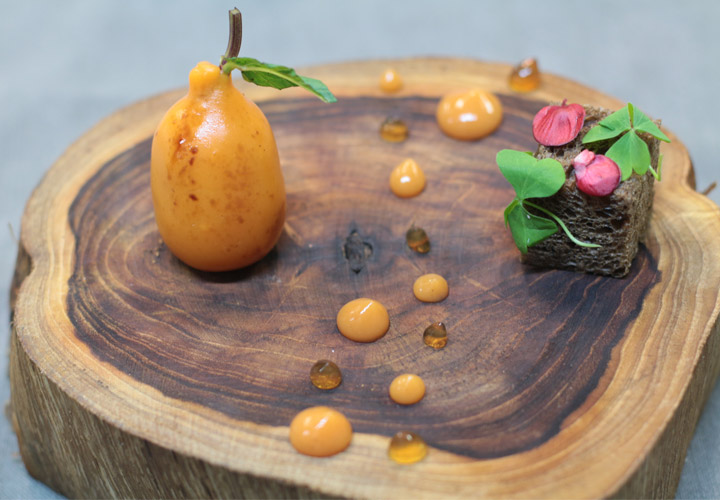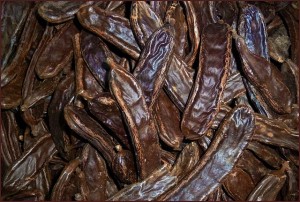Locust Bean Gum (LBG, carob gum)
Locust bean gum, often referred to by LGB, is a hydrocolloid that can be used by itself for thickening and in combination with other hydrocolloids such as xanthan gum for gelling. Locust bean gum is very effective to reduce syneresis (weeping) in kappa carrageenan and agar gels. In frozen products such as ice cream, locust bean gum slows down and reduces the size of ice crystal formation improving the mouthfeel of the end product by giving it a smooth texture without a slimy mouthfeel.
Locust Bean Gum Origin
Locust bean gum is milled from the locust bean, also known as the carob bean. For that reason, locust bean gum is sometimes referred to as "carob bean gum" or "carob gum." However, the gum should not be confused with carob powder, a flavoring made from roasted carob beans that can be used as a substitute for chocolate. The carob plant is also known as "St. John's Bread." The carob seeds grow in pods and have a uniform size—about 200 mg—leading medieval jewelers to use them as a standard weight, hence the origin of the carat.
Locust bean gum is often referred to by the acronym "LBG." Like guar gum, LBG is a galactomannan, a type of polysacharride.
Locust bean gum continues to be produced today how it was produced thousands of years ago. The best-known use case comes from Egypt, where locust bean gum was used to prepare mummies. Today, almost all commercially-produced locust bean gum is consumed by the food industry. Once a factory receives the beans, the beans are allowed to dry, then separated from their shells and ground to a fine powder.
Locust Bean Gum Function
Locust bean gum is primarily a thickener that forms viscous, shear thinning solutions. But LBG can form gels in combination with other hydrocolloids such as xanthan gum and is excellent in syneresis (weeping) control. Particularly good for dairy gels and ice creams.
Locust Bean Gum Applications
In frozen products, locust bean gum slows down and reduces the size of ice crystal formation thanks to its ability to bind water improving the mouthfeel of the end product. LBG works really well in ice cream thanks to the weak thermally irreversible gel that produces a smooth texture without giving ice cream a slimy mouthfeel; plus the gum provides meltdown resistance.
Locust bean gum is also great to stabilize dairy foams made with the iSi Whip, such as a milk shake foam. It can also be used to make hot fruit gels when combined with Xanthan gum.
In bakery fillings, locust bean gum makes them more stable and less likely to boil out. Locust bean gum will also provide a little bit of film formation, which will prevent the fruit prep from migrating into a pie shell.
Thanks to its creamy mouthfeel, it is typically found in cream-cheese spreads to impart richness and spreadability.
Locust bean gum is invaluable in commercial applications such as ice cream, soft drinks, fruit juices, bread and pastry, preserves, instant pudding and baby food.
In the Foie Gras Medlar and Roasted Barley Bread recipe, LBG is combined with agar agar to make a tangy gel from the medlar fruit. The addition of LBG reduces the syneresis (weeping) of the agar gel.

View recipes with Locust Bean Gum
Locust Bean Gum Properties
Temperature (gels and melts): Viscosity of an LBG-thickened solution increases as temperature decreases. LGB does not gel by itself so gelling and melting of the formed gel depends on the other hydrocolloid.
Texture: By itself, liquids thickened with LBG feel comparable to those thickened by guar gum or another hydrocolloid providing a viscous short-textured solution; it really shines when used with other ingredients to prevent syneresis or improve gel texture.
Appearance: Cloudy, though modified versions of LBG can be transparent.
Flavor release: Good.
Mouthfeel: When used alone, locust bean gum gives a smooth, thick and creamy mouthfeel. When combined with xanthan, a gum that it is synergistic with, a strong and rigid gel forms. At higher loading levels, the gel can be firm and elastic.
Freeze / Thaw stable: Yes
Syneresis (weeping): N/A by itself, but reduces syneresis in kappa carrageenan and agar gels.
Interactions and Tolerance of Locust Bean Gum
PH Tolerance: Between 4 and 7 with good acid stability.
Synergies with other ingredients: In combination with xanthan gum and/or kappa carrageenan, LBG forms mixed gels with an elastic texture, which show no syneresis. With Xanthan Gum it forms a strong rigid gel, even though neither LBG nor xanthan gels alone. At higher loading levels, the gel can be firm and elastic. When added to a kappa carrageenan gel, it softens its brittle, nearly sliceable texture to be more like a gelatin-type, elastic gel that is thermoreversible and improves clarity. LGB reduces syneresis in gels formed by other hydrocolloids, such as kappa carrageenan or agar. LGB increases viscosity of cellulose gums.
How to use Locust Bean Gum
Concentration Range: Use between 0.1% to 1% LBG for most applications. To thicken most liquids, use 0.1% LBG. To prevent syneresis in agar gels, replace 0.1%-0.2% agar with locust bean gum. Use 0.2% LBG in pastry fillings to make them more stable. To make sorbet, use 0.35% LBG. To make a firm and brittle cold gel with no syneresis, use 0.4% LGB with 0.2% Kappa. For an elastic hot fruit gel use 0.8% LBG with 0.2% xanthan gum. As ice cream stabilizer, use 0.15% LBG, 0.30% glycerin flakes and 0.02% kappa carrageenan.
Dispersion: Disperse in cold water. Make a slurry of the powder in cold water. You can premix with 3 parts sugar or other powder ingredients to improve dispersion.
Hydration: Hot soluble at above 80 ˚C (176 ˚F). Mix dispersed LBG with other ingredients and boil for three minutes to fully hydrate. Salt, sugar and other ingredients that compete for water can slow the hydration rate.
Setting: Will only gel in the presence of xanthan gum, agar or kappa carrageenan.
Chemical Reaction
Carob seeds are used to produce locust bean (or carob) gum, a galactomannan polysaccharide with a molecular weight of 400,000 to 1,000,000, made up of long chains of the sugars galactose and mannose. The main chain consists of (1-4) linked β-D mannose residues, and the side chains are (1-6) linked α-D galactose. Its composition varies, but it usually has approximately 3.5 randomly distributed mannose residues for every galactose residue, although that number can range from 2.8 to 4.9. This structure can affect the properties: Less galactose increases the chains’ flexibility, but increases their extensibility. This structure is similar to that of guar gum, but the uneven side-chain distribution makes it less soluble and less viscous. It forms weak, thermally irreversible gels due to the association of the parts of the chains lacking galactose residues. Reducing temperature and water activity can increase this association, allowing the formation of a 3-D network and gel. This is the reason LBG works so well in ice cream: The weak gel produces a smooth texture and doesn’t give ice cream a slimy mouthfeel, plus the gum provides meltdown resistance.




 (4 votes, average: 4.75)
(4 votes, average: 4.75)

